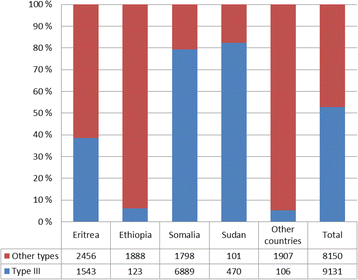Estimating the magnitude of female genital mutilation/cutting in Norway: an extrapolation model
- PMID: 26837303
- PMCID: PMC4739093
- DOI: 10.1186/s12889-016-2794-6
Estimating the magnitude of female genital mutilation/cutting in Norway: an extrapolation model
Abstract
Background: With emphasis on policy implications, the main objective of this study was to estimate the numbers of two main groups affected by FGM/C in Norway: 1) those already subjected to FGM/C and therefore potentially in need for health care and 2) those at risk of FGM/C and consequently the target of preventive and protective measures. Special attention has been paid to type III as it is associated with more severe complications.
Methods: Register data from Statistics Norway (SSB) was combined with population-based survey data on FGM/C in the women/girls' countries of origin.
Results: As of January 1(st) 2013, there were 44,467 first and second-generation female immigrants residing in Norway whose country of origin is one of the 29 countries where FGM/C is well documented. About 40 pct. of these women and girls are estimated to have already been subjected to FGM/C prior to immigration to Norway. Type III is estimated in around 50 pct. of those already subjected to FGM/C. Further, a total of 15,500 girls are identified as potentially at risk, out of which an approximate number of girls ranging between 3000 and 7900 are estimated to be at risk of FGM/C.
Conclusion: Reliable estimates on FGM/C are important for evidence-based policies. The study findings indicate that about 17,300 women and girls in Norway can be in need of health care, in particular the 9100 who are estimated to have type III. Preventive and protective measures are also needed to protect girls at risk (3000 to 7900) from being subjected to FGM/C. Nevertheless, as there are no appropriate tools at the moment that can single these girls out of all who are potentially at risk, all girls in the potentially at risk group (15,500) should be targeted with preventive measures.
Figures
Similar articles
-
Estimates of first-generation women and girls with female genital mutilation in the European Union, Norway and Switzerland.Eur J Contracept Reprod Health Care. 2016 Dec;21(6):474-482. doi: 10.1080/13625187.2016.1234597. Epub 2016 Sep 21. Eur J Contracept Reprod Health Care. 2016. PMID: 27652839
-
Female Genital Mutilation/Cutting in the United States: Updated Estimates of Women and Girls at Risk, 2012.Public Health Rep. 2016 Mar-Apr;131(2):340-7. doi: 10.1177/003335491613100218. Public Health Rep. 2016. PMID: 26957669 Free PMC article.
-
Estimating the number of women with female genital mutilation in Belgium.Eur J Contracept Reprod Health Care. 2011 Aug;16(4):248-57. doi: 10.3109/13625187.2011.579205. Epub 2011 May 11. Eur J Contracept Reprod Health Care. 2011. PMID: 21561227
-
Towards a better estimation of prevalence of female genital mutilation in the European Union: a situation analysis.Reprod Health. 2020 Jul 8;17(1):105. doi: 10.1186/s12978-020-00947-2. Reprod Health. 2020. PMID: 32641062 Free PMC article. Review.
-
Care of women with female genital mutilation/cutting.Swiss Med Wkly. 2011 Jan 6;140:w13137. doi: 10.4414/smw.2011.13137. eCollection 2011. Swiss Med Wkly. 2011. PMID: 21213149 Review.
Cited by
-
Virility, pleasure and female genital mutilation/cutting. A qualitative study of perceptions and experiences of medicalized defibulation among Somali and Sudanese migrants in Norway.Reprod Health. 2017 Feb 10;14(1):25. doi: 10.1186/s12978-017-0287-4. Reprod Health. 2017. PMID: 28187741 Free PMC article.
-
A system analysis of the mental health services in Norway and its availability to women with female genital mutilation.PLoS One. 2020 Nov 4;15(11):e0241194. doi: 10.1371/journal.pone.0241194. eCollection 2020. PLoS One. 2020. PMID: 33147265 Free PMC article.
-
Negotiating Female Genital Cutting in a Transnational Context.Qual Health Res. 2021 Feb;31(3):458-471. doi: 10.1177/1049732320979183. Qual Health Res. 2021. PMID: 33427072 Free PMC article.
-
Health sector involvement in the management of female genital mutilation/cutting in 30 countries.BMC Health Serv Res. 2018 Apr 4;18(1):240. doi: 10.1186/s12913-018-3033-x. BMC Health Serv Res. 2018. PMID: 29615033 Free PMC article.
-
The socioeconomic dynamics of trends in female genital mutilation/cutting across Africa.BMJ Glob Health. 2020 Oct;5(10):e003088. doi: 10.1136/bmjgh-2020-003088. BMJ Glob Health. 2020. PMID: 33051284 Free PMC article.
References
-
- Eliminating Female Genital Mutilation . An Interagency Statement. Geneva, Switzerland: World Health Organization; 2008.
-
- Rahman A, Toubia N. Female genital mutilation: A practical guide to worldwide laws & policies: Zed Books; London. 2000.
Publication types
MeSH terms
LinkOut - more resources
Full Text Sources
Other Literature Sources
Research Materials



